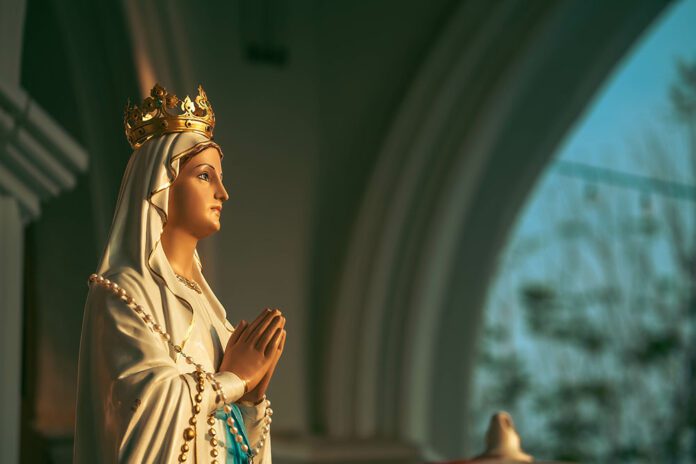Ancient Spain produced a rare gem in the devotion, Crown of the Virgin. This ancient meditation highlights the beauty, sanctity, and virtue of the Blessed Mother. The work itself is a masterpiece that artfully decorates Our Lady’s crown with twelve jewels, six stars, and six flowers. Each one allows the devotee to meditate on some aspect of Our Lady’s virtue and beauty. The devotion is attributed to St. Ildephonsus of Toledo. He lived from 607 to 670 A.D. as a monk at the monastery of Agali. He became abbot and later the Archbishop of Toledo. He is best known for his work, On the Perpetual Virginity of Most Blessed Mary. This particular work, Crown of the Virgin, was originally titled, Libellus de Corona Virginis — The Little Book on the Crown of the Virgin. Fr. Robert Nixon’s translation is the best for those searching to grow closer to Our Lady and connect with ancient Spain’s saint, Ildephonsus.
This devotion maintains that the Virgin’s crown contains twenty-four places with each holding a jewel, star, or flower. The twelve jewels chosen are: Topaz, the Carnelian Gemstone, Chalcedony, Sapphire, Agate, Jasper, Ruby, Emerald, Amethyst, Peridot, Jade, and Beryl. These precious stones are selected for their unique and radiant qualities that reflect the Virgin Mary’s attributes. The precious ruby is found in the thirteenth position of Mary’s crown representing her luminosity and illumination in darkness. This one example of the gems that adorn Mary’s crown reminds one that she is the shining and irresistible light when darkness looms and threatens one’s peace.
Additionally, Mary’s crown holds six stars that encompass her many attributes. These are: the Morning Star Sirius, the Star Arcturus, the Star of the Sea, the Sun, the Moon, and the Star Orion. Many are familiar with the Marian title, Star of the Sea, for Our Lady. Some may also recall the image of Our Lady of Guadalupe where the sun is behind Mary while her feet rest upon the moon. Picturing the stars Arcturus and Orion may seem more puzzling. St. Ildephonsus paints the Star Arcturus as the sixth place in Our Lady’s Crown as this star is surrounded by seven lesser stars. He writes, “For you are star-like in your purity and most dazzling in your faith and sanctity. With seven stars — just as with seven virtues — you are gloriously adorned.” These seven virtues are: faith, love, hope, temperance, fortitude, justice, and prudence. In this list, the three Theological virtues are joined with the four Cardinal virtues emphasizing how Our Lady was truly fit to be the Ark of the Covenant carrying the Christ in her womb. Similarly, the Star Orion holds the twenty-second place in Mary’s crown, establishing Mary’s queenship. St. Ildephonsus writes, “And, like Orion, your appearance brings with it gentle and welcome rain — the refreshing rain of grace and devotion, the nourishing rain of repentance and contrition, the transforming rain of compunction and tears, the delightful rain of sweetness and consolation.”
Similarly, Mary was a beautiful and glorious flower throughout her life, so St. Ildephonsus’ choice in flowers is quite important. For the six, he chooses: the Lily, Crocus, Rose, Violet, Sunflower, and Daisy. Again, some of these we see throughout history as representing Mary, but the Crocus, Sunflower, and Daisy are rarely mentioned. The Crocus is placed eighth in the Crown of the Virgin representing her golden sanctity that brings joy and healing. The Sunflower graces the twentieth position in Mary’s Crown. It reflects Mary’s faithfulness to God, especially her Son. Christ is oftentimes represented with the sun, and the sunflower always looks to the sun. In this way, St. Ildephonsus reminds devotees that Our Lady does the same suffering and rejoicing with Christ — always remaining faithful. The twenty-fourth position in Our Lady’s Crown is the final place in which the Daisy rests. St. Ildephonsus states that Our Lady is the “magnum opus.” This Latin word literally translates to “Great Work,” or more commonly, masterpiece. Mary truly is God’s masterpiece, which is why the daisy is chosen last as its simplicity reflects Mary’s humility, and its beauty is undeniable, just like Our Lady’s. The Crown of the Virgin devotion provides a remarkable glimpse into Catholic history’s ancient devotions. Although the original work may be ripened by age and weathered pages, it most certainly has not ripened beyond the point of sweetness for those in the modern age looking to connect with the history of the Church and her most beloved Mother.






